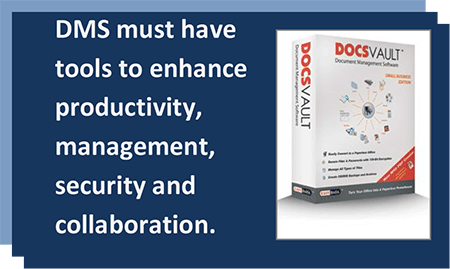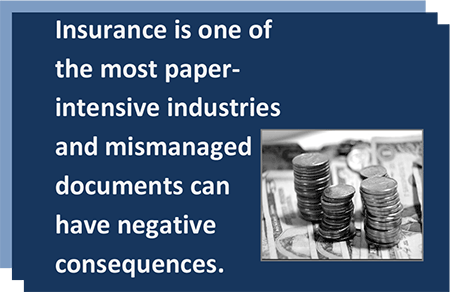White Paper: DMS For Insurance Industry
Overview
One of the most paper intensive industries is insurance industry. There are endless forms to fill, copies of proofs to be preserved, and claims to deal with on regular basis. Under the circumstances, using simple word processors, insecure repository and emails or not adopting a streamlined process of document management can have serious negative consequences.
Being a data-driven industry, insurance agencies and firms have to be careful with their documents. They are responsible for taking care of huge amounts of documents such as policy applications, contracts, customer proofs, policyholder agreements, claim forms, PIP & HCFA forms, etc.
Apart from this, they also need to handle customer enquiries efficiently and quickly. Lack of immediate response may also mean loss of customers to competition who can handle queries readily. For all these, Managing documents effectively is critical in insurance industry. A failure to effectively manage and control documents can result in loss of time, productivity and even customers.
Adopting technological solutions in your insurance agency can reduce the turnaround time of solving customer queries from standard 24 hours to less than a minute. You can function more effectively and enhance your business all while reducing costs. Insurance document management technology allows individuals to manage documents efficiently and securely, and at the lowest possible cost in terms of both direct expenses and personal productivity.
Scenario in Insurance Industry
The nature of work in insurance industry is such that one would find them self immersed in mammoth-sized paper and digital records, which need a lot of sorting and sifting before one finds the information that is needed.
Ad-hoc document management policy can lead to inefficiency, document control problems, lack of good customer service and more serious consequences in near future. Let’s take an example of a mid-sized insurance agency that did not adopt document management system. This agency had stored paper documents in a safe vault, which could be accessed only by a few authorized personnel. If a junior relationship executive wanted some information, he had to rely on authorized relationship manager to fetch him that information. Policy statements and certain documents were scanned but the staff had no clue how to access the digital documents. If a customer called with a query, he would be asked to wait for a few hours to a day before they could return with the required information. Even then, the staff was not well equipped to answer all enquiries. Result: Customer did not renew his policy and went to the competitor.
Document management and control
- Ad-hoc document storage and organizing policy result in employees wasting many hours simply looking for information. Every relevant document should be scanned and made available to authorized staff, which often doesn’t happen under the circumstances.
- While some documents can be shared with some users, some can’t be. Lack of user/group based security rights can lead to security breaches and unauthorized use of data.
- Without a centralized repository, employees don’t have access to latest versions or files and need a longer turnaround time to answer customers.
- Outdated communication and sharing methods translate to lost time, productivity and reputation.
Document alerts and reminders
When document alert system is not maintained or followed, companies can fail to inform customers about policy renewals and other events. With a powerful document alert system, even if a junior executive calls a customer, he can have all the information he needs on fingertips.
Timely completion of tasks
It is easier to complete a task when deadlines are set and reviewers receive notification about all task updates. This improves efficiency in the agency.
Lack of unified technological solutions
Instead of investing in separate technological solutions, it is advisable to adopt feature-filled document management system that offers integrated scanning, OCR add on, workflow and document routing, alerts and reminders, document tagging, quick searching and other useful features that allow insurance industry to work more efficiently.
Insurance document management features
The features that insurance industry must seek in Document Management Software depends on the number of documents they create and store every year, the size of the organization, and the current customer service policy.

Document Management Features
Document management, as the name suggests, helps manage documents with the help of its salient features that make the task of creating, sharing, storing, retrieving, securing and reviewing documents easier. These features enhance productivity of employees, help manage documents effectively, secure documents against misuse and improve in-house collaboration and customer satisfaction.
Document Management Tools
- Metadata and document profiling for structured organization and e-discovery purposes
- Document versioning and relations to quickly find right documents to edit and review
- MS Word and Excel to PDF conversion and PDF manipulation
Critical Productivity Tools for Insurance Agents
- MS Office Integration to quickly save and edit MS files
- Integrated scanning to speed up complex scanning jobs
- Quick search options to find documents in no time
Fine-grained Security for Documents
- User / Group based security to keep your most sensitive documents safe
- Audit document change history to for regulatory compliance mandates such as SOX
- Document export prevention to prevent data theft and leakage
Collaboration and communication features
- Simple workflow management with features like document routing and task flow
- Document notes and task notes to keep brief but important notes
- Alerts and reminders to increase responsiveness and serve customers better
How Can Document Management Help?
Document management system, unlike the name suggests, helps in much more than managing documents. Insurance agencies adopt this technological solution to improve their performance and services, reduce the risk of misuse of their documents and meet regulatory requirements.
Why the need for insurance document management system?
Since the time of data acquisition until the end of life of documents, document management software can help. It offers a structured environment to integrate all data and make it readily available. It allows making regular quality checks with tools like version control and prevents data exploitation with the help of security tools.
Manage documents better
Insurance document management allows insurance agencies and companies to have a centralized document storage policy, scan all paper documents and preserve metadata through document profile, so that they never lose a document again.
Enhance employee performance
Collaboration tools such as email, shared repository, concurrent access to documents improve collaboration between employees. Search tools such as full text search, keyword search, date, name, metadata search allow employees to find documents quickly improve their response turnaround time. Simple workflow features such as document routing, task notification and alerts help in timely completion of tasks.
Increase customer satisfaction
One of the most crucial tasks for insurance industry is keeping their customer happy. Unlike some industries, insurance industry needs to maintain long-term relationship with their customers. Document management software offers features such as quick email, faster search and alerts and reminders, so that the company never misses an opportunity to impress the customer.
Reduce risk of fraudulent claims
Having a controlled environment, where users or groups of users are pre-authorized to view or modify certain documents; role-based rights to allow viewing and editing but not exporting or deleting documents; ownership overrides to maintain the ownership of files created by other users, etc. prevent misuse of documents, reducing the risk of fraudulent claims.
Meet regulatory requirements
Insurance companies, big or small, are striving for higher corporate accountability and governance in the face of stricter regulatory requirements and rising customer expectations. Document management system allows them to meet numerous insurance regulatory compliance mandates from national and regional supervisory authorities such as HIP AA, NAIC, CIPR, FFIEC and SOX.
Questions to Ask
What happens when DMS is not easy to use?
One may invest heavily in expensive document management software only to find that it is very complicated and users prefer to manage their documents traditionally rather than spending their valuable time learning and using this technology.
How much should one spend on DMS?
The price of document management software ranges anywhere between $500 to $2000 for 3 users. How much should one spend on DMS depends on the needs of organization and its budget. However, However, expensive always does not mean better and one must not discard any option before carefully weighing its pros and cons.
Do we really need DMS?
Technology is often likened to white elephants. However, many insurance companies have been using DMS for years and assert its benefits vocally. Simply said, you can do without DMS, but you can do better with DMS.
Can DMS improve productivity and enhance customer satisfaction?
DMS can improve productivity of employees by cutting down their monotonous jobs, making information readily available, speeding up regular tasks and smoothing internal communication and collaboration. All this cumulatively has a positive effect on customer satisfaction. Also some features like alerts and reminders directly influence customer satisfaction.
Docsvault as a solution
Any firm that deals with a lot of documents and want to improve client satisfaction need DMS. Docsvault emerges as a viable solution for insurance industry because it fulfills needs specific to this industry and has many salient attributes such as affordability and ease of use.
Conclusion
Document management is a good investment and Docsvault is one of the most favored document management software in insurance industry because of its simplicity, flexibility and affordability. It helps improve business processes with features such as easy search function, metadata, reminders, version control, security and audit trail.

